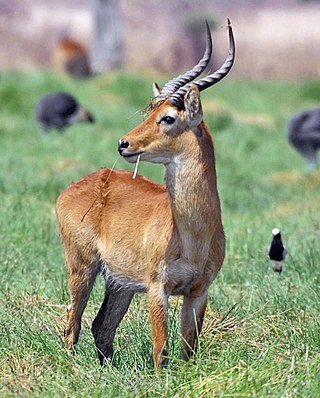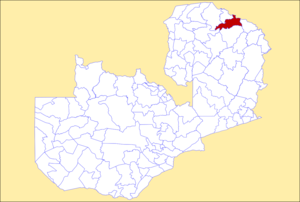
Zambia, officially the Republic of Zambia, is a landlocked country at the crossroads of Central, Southern and East Africa. It is typically referred to being in South-Central Africa or Southern Africa. It is bordered to the north by the Democratic Republic of the Congo, Tanzania to the north-east, Malawi to the east, Mozambique to the southeast, Zimbabwe and Botswana to the south, Namibia to the southwest, and Angola to the west. The capital city of Zambia is Lusaka, located in the south-central part of Zambia. The population is concentrated mainly around Lusaka in the south and the Copperbelt Province to the north, the core economic hubs of the country.
Mchinji is a town and the capital of the Mchinji District in the Central Region of Malawi. Mchinji Boma, located 12 kilometres from the Zambian border and 109 km (68 mi) from the national capital, Lilongwe, is the major hub of government and general business. It has a major railroad junction, being the railhead nearest to Zambia. The area's economy is sustained by rain-fed agriculture.

The puku is a medium-sized antelope found in wet grasslands in southern Democratic Republic of Congo, Namibia, Tanzania, Zambia and more concentrated in the Okavango Delta in Botswana. Nearly one-third of all puku are found in protected areas, zoos, and national parks due to their diminishing habitat.

Northern Province is one of Zambia's ten provinces. It covers approximately one-sixth of Zambia in land area. The provincial capital is Kasama. The province is made up of 12 districts, namely Kasama District, Chilubi District, Kaputa District, Luwingu District, Mbala District, Mporokoso District, Mpulungu District, Mungwi District, Nsama District, Lupososhi District, Lunte District and Senga Hill District. Currently, only Kasama and Mbala have attained municipal council status, while the rest are still district councils. It is widely considered to be the heartland of the Bemba, one of the largest tribes in Zambia.
Salima is a district in the Central Region of Malawi. The city of Salima is the district's capital. The district covers an area of 2,196 km.² and has a population of 478,346. The beach at Senga Bay is the weekend retreat of many from the capital, Lilongwe, and has hosted the annual Lake of Stars festival since 2008, when it was moved from Chintheche in order to be less remote. There is a range of accommodation options in the area, though most are a few kilometers off the main road.

The Chewa are a Bantu ethnic group found in Malawi, Zambia and few in Mozambique. The Chewa are closely related to people in surrounding regions such as the Tumbuka and Nsenga. They are historically also related to the Bemba, with whom they share a similar origin in the Democratic Republic of the Congo. As with the Nsenga and Tumbuka, a small part of Chewa territory came under the influence of the Ngoni, who were of Zulu or Natal/Transvaal origin. An alternative name, often used interchangeably with Chewa, is Nyanja. Their language is called Chichewa. Internationally, the Chewa are mainly known for their masks and their secret societies, called Nyau, as well as their agricultural techniques.

The ten provinces of Zambia are divided into a total of 116 districts as of 2018.
The Mambwe are an ethnic group from Mbala and Senga Hill district of Northeastern Zambia and Kalambo District of Rukwa Region, Tanzania. In 1987 the Mambwe population in Tanzania was estimated to number 63,000. The number of Mambwe in Zambia has not been independently estimated, though the combined number of Mambwe and Lungu people in Zambia was estimated to be 262,800 in 1993.

Chama District with the headquarters at Chama is the largest district of the Eastern Province in Zambia and includes a large wilderness in the Upper Luangwa valley just north-east of the North Luangwa National Park. It is made up of two constituencies, namely Chama North and Chama South.
Nsenga, also known as Senga, is a Bantu language of Zambia, Malawi and Mozambique, occupying an area on the plateau that forms the watershed between the Zambezi and Luangwa river systems and Western Malawi land overshadowing Kachebere mountain called Mchinji.
The Senga are an ethnic tribe of Zambia, distinct from the Nsenga.

Kodai Senga is a Japanese professional baseball pitcher for the New York Mets of Major League Baseball (MLB). He made his Nippon Professional Baseball (NPB) debut in 2012 for the Fukuoka SoftBank Hawks, and played for them until 2022. He is a three-time NPB All-Star and a one-time MLB All-Star.

Senga Hill is a constituency of the National Assembly of Zambia. It covers the towns of Nendo and Senga Hill in Senga Hill District of the Northern Province. The constituency is home to the Mambwe and Lungu people of Zambia.

Chisamba District is a district of Central Province, Zambia. It covers a total surface area of 5,526 sq.km and is known for its agricultural activities with over 32,000 small scale farming families and 256 commercial farmers, the majority of whom are white Zambians. It shares borders with Lusaka, Chongwe, Chibombo, Kabwe, Kapiri Mposhi and Luano Districts. The District has a total population of 103,983 of which 51,955 are females and 52,028 are males.

Shibuyunji District, also known as Sibuyunji District, is a district of Central Province, Zambia.

Ikelenge District is a district of North-Western Province, Zambia. It was separated from Mwinilunga District in 2011.

Mushindamo District is a district of North-Western Province, Zambia. It was created from part of Solwezi District in 2016. However, as of 2021, it is not clear where the Mushindamo Central Business District is to be located.

Lumezi District is a district of Eastern Province, Zambia. It was made independent from Lundazi District in 2018.
The M1 road is a road in northern Zambia. It connects Mpika in Muchinga Province with Mbala in the Northern Province on the border with Tanzania and the Lake Tanganyika port of Mpulungu via Kasama. The northern section is a toll road.












